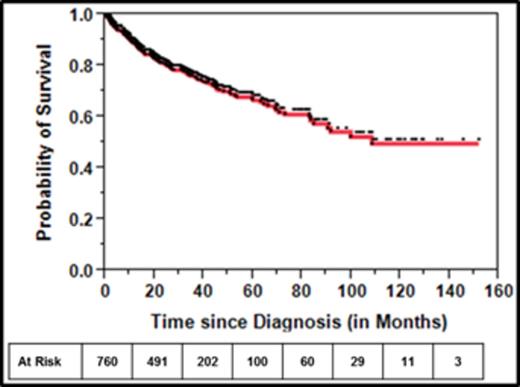Background: Large granular lymphocyte (LGL) leukemia is a lymphoproliferative disorder of mature cytotoxic T- or Natural Killer (NK)-cells. T-cell LGL (T-LGL) leukemia is characterized by accumulation of cytotoxic T-cells in blood and infiltration of the bone marrow, liver, or spleen. T-LGL leukemia may manifest as asymptomatic persistent lymphocytosis or present with a myriad of autoimmune diseases including autoimmune cytopenias. Population-based studies have not been reported in LGL leukemia. Here, we present clinical characteristics, natural history, and risk factors for poor survival in patients with T-LGL leukemia using the Surveillance, Epidemiology, and End Results Program (SEER) and the National Cancer Data Base (NCDB), the two largest national cancer registries in the US.
Methods: We queried the SEER and NCDB databases using ICD-O histology code 9831 corresponding to LGL leukemia. The query was further refined to include patients with T-LGL leukemia only. Incidence rates (case/1,000,000) were calculated using 2000-2011 data from SEER and age-adjusted to the US 2000 standard population. Patient level data were obtained from the NCDB and used to describe patient characteristics such as demographics, year of diagnosis, treatment, and survival.
Results: The incidence of LGL leukemia was 0.2 cases/1,000,000 individuals. The incidence did not change significantly over the period of time studied. The incidences according to racial groups were (mean, 95%CI): White 0.2 (0.18-0.24), Black 0.14 (0.07-0.24), American Indian/Alaska native 0.24 (0.03-0.8), and Asian/Pacific Islander 0.15 (0.07-0.25). The incidences among Blacks, American Indians/Alaska Natives, or Asian/Pacific Islanders were not significantly different compared to Whites. Patient-level data was available for 978 patients with T-LGL leukemia. The median age at diagnosis was 66.5 years (range, 19-90) with a male to female ratio of 1.05. Females were diagnosed at a younger age compared to males (65 vs. 68 years, p<0.05). Forty-five percent of the patients with T-LGL leukemia required some form of systemic treatment at the time of diagnosis. The vital status of 760 (77.7%) patients was known at the time of last follow up with a median follow up of 32 months (range, 0-152). At the time of last follow up, 75.5% were alive with the median overall survival (OS) of 108.4 months (Figure 1). Multivariate analysis that included age at diagnosis, sex, race, year of diagnosis, and Charlson-Deyo co-morbidity score, showed that older age (>60 years) and higher co-morbidity score (≥2) were independent predictors of poorer survival (Table 1).
Conclusions: We present the first population-based study of patients with LGL leukemia, an extremely rare disease. The incidence has remained stable over the last decade and does not vary significantly among races. Most patients with T-LGL leukemia do not require treatment and the overall prognosis is relatively good.
Multivariable analysis showing predictors of mortality in patients with T-LGL leukemia
| Parameter . | Hazard Ratio . | Lower CI . | Upper CI . | P -Value . |
|---|---|---|---|---|
| Age <60 vs ≥ 60 years | 2.73 | 1.90 | 4.04 | <.0001 |
| Male vs Female | 0.82 | 0.61 | 1.09 | 0.19 |
| White vs Other | 0.99 | 0.97 | 1.00 | 0.23 |
| Charlson-Deyo score <2 vs ≥2 | 2.03 | 1.29 | 3.06 | 0.003 |
| Year of Diagnosis (2001-2006 vs. 2007-2012) | 1.11 | 0.76 | 1.69 | 0.58 |
| Parameter . | Hazard Ratio . | Lower CI . | Upper CI . | P -Value . |
|---|---|---|---|---|
| Age <60 vs ≥ 60 years | 2.73 | 1.90 | 4.04 | <.0001 |
| Male vs Female | 0.82 | 0.61 | 1.09 | 0.19 |
| White vs Other | 0.99 | 0.97 | 1.00 | 0.23 |
| Charlson-Deyo score <2 vs ≥2 | 2.03 | 1.29 | 3.06 | 0.003 |
| Year of Diagnosis (2001-2006 vs. 2007-2012) | 1.11 | 0.76 | 1.69 | 0.58 |
Overall survival in patients with T-LGL leukemia
No relevant conflicts of interest to declare.
Author notes
Asterisk with author names denotes non-ASH members.


